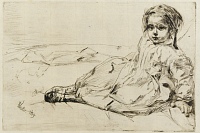Etchings Institutions search term: british museum
Bibi Valentin | ||
| Number: | 34 | |
| Date: | 1859 | |
| Medium: | etching and drypoint | |
| Size: | 152 x 228 mm | |
| Signed: | 'Whistler.' at lower left | |
| Inscribed: | '1859.' at lower left | |
| Set/Publication: | no | |
| No. of States: | 2 | |
| Known impressions: | 44 | |
| Catalogues: | K.50; M.50; T.26; W.28 | |
| Impressions taken from this plate (44) | ||
TECHNIQUE
While Lochnan describes the print as a drypoint, 6 much of the work is etched, with drypoint employed for shading, highlights and the background lines.
6: Lochnan 1984 .
According to Howard Mansfield (1849-1938) he owned an impression of the first state plus 'a counter-proof of this state, retouched with pencil - the only counter-proof of a Whistler etching known to the compiler.' 7 This has not been located. It was not the only counterproof - there is one of The Dyer
[192] dating from the 1880s ( ).
).
 ).
).7: Mansfield 1909 (cat. no. 50).
A badly damaged impression of the second state, with the scratch on the sofa, is touched with graphite pencil on the head, with shading on the hair, forehead, the bridge of the nose and to the right of it ( ). However, it is not a first state, not known to have been owned by Mansfield, and not necessarily touched up by Whistler.
). However, it is not a first state, not known to have been owned by Mansfield, and not necessarily touched up by Whistler.
 ). However, it is not a first state, not known to have been owned by Mansfield, and not necessarily touched up by Whistler.
). However, it is not a first state, not known to have been owned by Mansfield, and not necessarily touched up by Whistler.PRINTING
There are over forty known impressions of Bibi Valentin, which is an exceptional number for an etching that was never published.
The sole recorded impression of the first state has not been located, neither has a counterproof, which was once owned by Howard Mansfield (1849-1938).
At some point after 1872, but before 1878, the plate, still in the second state, appears to have been damaged, with a conspicuous meandering scratch at left. Later impressions of this state, which can be dated up to 1883, were also printed in black ink, both on Asian and western papers. Papers include cream laid Japan ( ,
,  ) and thin, translucent cream Asian laid paper (
) and thin, translucent cream Asian laid paper ( ). Others were printed on western cream 'antique' (pre-1800) laid paper (
). Others were printed on western cream 'antique' (pre-1800) laid paper ( ); medium-weight ivory laid paper (
); medium-weight ivory laid paper ( ) and a heavy-weight off-white laid paper (
) and a heavy-weight off-white laid paper ( ).
).
 ,
,  ) and thin, translucent cream Asian laid paper (
) and thin, translucent cream Asian laid paper ( ). Others were printed on western cream 'antique' (pre-1800) laid paper (
). Others were printed on western cream 'antique' (pre-1800) laid paper ( ); medium-weight ivory laid paper (
); medium-weight ivory laid paper ( ) and a heavy-weight off-white laid paper (
) and a heavy-weight off-white laid paper ( ).
).It is possible that the plate was either restored, or printed carefully to minimise the effect of the scratch, with impressions being printed in the 1890s or later. Impressions were printed in black ink on various papers: pale buff laid paper with a Strasbourg Lily watermark ( ); watermarked 'J. Bouchet' (
); watermarked 'J. Bouchet' ( ); pale buff laid paper (
); pale buff laid paper ( ) and buff Japanese laid (
) and buff Japanese laid ( ). They were professionally printed but not, apparently, by Whistler (none are signed by the artist). Few are dated though Frederick Keppel (1845-1912) gave one to a friend in 1897 (
). They were professionally printed but not, apparently, by Whistler (none are signed by the artist). Few are dated though Frederick Keppel (1845-1912) gave one to a friend in 1897 ( ). It is possible that Keppel owned the plate and organised the late print-run.
). It is possible that Keppel owned the plate and organised the late print-run.
 ); watermarked 'J. Bouchet' (
); watermarked 'J. Bouchet' ( ); pale buff laid paper (
); pale buff laid paper ( ) and buff Japanese laid (
) and buff Japanese laid ( ). They were professionally printed but not, apparently, by Whistler (none are signed by the artist). Few are dated though Frederick Keppel (1845-1912) gave one to a friend in 1897 (
). They were professionally printed but not, apparently, by Whistler (none are signed by the artist). Few are dated though Frederick Keppel (1845-1912) gave one to a friend in 1897 ( ). It is possible that Keppel owned the plate and organised the late print-run.
). It is possible that Keppel owned the plate and organised the late print-run.
